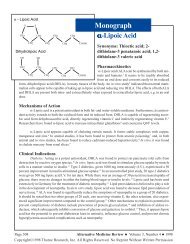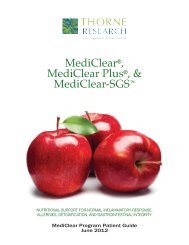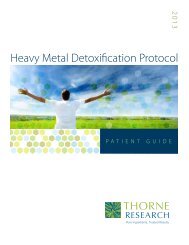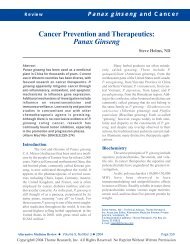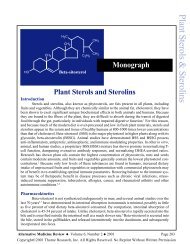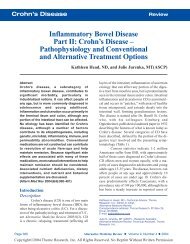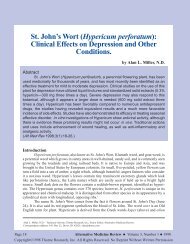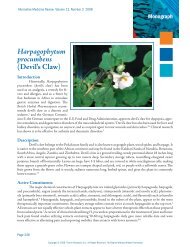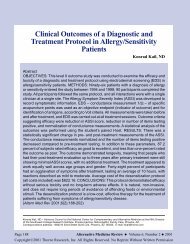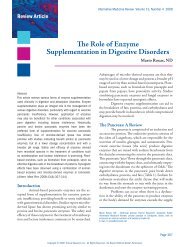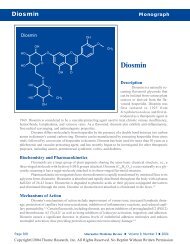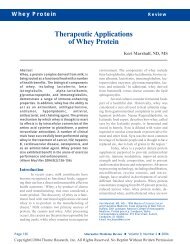Inulin-Type Prebiotics â A Review: Part 1 - Alternative Medicine ...
Inulin-Type Prebiotics â A Review: Part 1 - Alternative Medicine ...
Inulin-Type Prebiotics â A Review: Part 1 - Alternative Medicine ...
Create successful ePaper yourself
Turn your PDF publications into a flip-book with our unique Google optimized e-Paper software.
<strong>Review</strong> Article<br />
<strong>Alternative</strong> <strong>Medicine</strong> <strong>Review</strong> Volume 13, Number 4 2008<br />
Langlands et al gave an oligofructose-enriched<br />
inulin HP product (7.5 g oligofructose and 7.5 g inulin<br />
HP daily) for two weeks to 14 subjects recruited from<br />
colonoscopy waiting lists. Oligofructose-enriched inulin<br />
HP significantly increased mucosal Bifidobacteria and<br />
Lactobacilli in the proximal and distal colon as assessed<br />
by culture-based methods. No changes in total anaerobes,<br />
Clostridia, Bacteroides, or coliforms were reported. 41<br />
Dose-relationship to Prebiotic Activity<br />
In terms of Roberfroid’s second question –<br />
whether there is a dose-response effect – few studies<br />
have investigated this topic. Roberfroid tried to answer<br />
this question by reviewing individual trials to assess bifidogenic<br />
responses and doses of inulin-type prebiotics<br />
used. He concluded a limited dose effect exists, but went<br />
on to state, “…it is the fecal flora composition (especially<br />
the number of Bifidobacteria before the prebiotic treatment)<br />
characteristic of each individual that determines<br />
the efficacy of a prebiotic but not necessarily the dose<br />
itself.” 2 So while some degree of dose-effect does exist,<br />
an individual’s response is dictated by other factors in<br />
addition to dose.<br />
Current evidence indicates modest daily intake<br />
of inulin-type prebiotics of 2.5-5 g can have a bifidogenic<br />
effect in adults, 35,38,43,49 and is possibly the low end<br />
of the therapeutic dosing range. The limited direct comparative<br />
data suggests a modest dose effect is observed<br />
for higher doses up to 10 g daily in adults.<br />
Bouhnik et al conducted a dose-response study<br />
of FOS supplementation to 40 healthy volunteers. Subjects<br />
were randomly divided into five groups, with each<br />
group receiving a daily dose of 2.5, 5.0, 7.5, or 10 g FOS<br />
or placebo for seven days. Bifidobacteria counts increased<br />
in all FOS groups, with a positive correlation<br />
between the dose and fecal Bifidobacteria counts. Total<br />
anaerobes increased at the 10-g daily dose, but not at<br />
lower doses, while no significant differences were found<br />
for Bacteroides, Lactobacillus, or Enterobacteriaceae. 34<br />
In an earlier study, Bouhnik et al also reported a doserelated<br />
bifidogenic response to FOS in healthy volunteers.<br />
Although doses of 10 g and 20 g daily resulted in<br />
statistically significant increases in fecal Bifidobacteria<br />
compared to lower doses, the authors concluded the<br />
optimal daily dose for increasing Bifidobacteria while<br />
minimizing side effects was 10 g. 34<br />
It is unclear whether there is a dose above<br />
which a modest dose-response effect ceases to exist.<br />
However, one study in infants suggests the possibility of<br />
a biphasic response. In the study cited earlier by Euler<br />
et al, formula-fed term infants were given a cow’s milk<br />
formula with or without oligofructose at doses of 1.5 g<br />
oligofructose/liter or 3.0 g oligofructose/liter. While a<br />
bifidogenic effect was observed for both doses, the mean<br />
increase in Bifidobacteria was significantly greater with<br />
the lower dose. 10<br />
Taken as a whole, it appears some minimal dose<br />
of inulin-type prebiotic is needed to produce a bifidogenic<br />
effect. However, intraindividual response to an identical<br />
dose of the same inulin-type prebiotic, in terms of stimulation<br />
of total number of Bifidobacteria and individual<br />
Bifidobacteria species, can be extremely variable.<br />
Influence of Existing Gut Flora on<br />
Prebiotic Activity<br />
Several researchers believe an important parameter<br />
in terms of a bifidogenic effect (and possibly on<br />
growth stimulation of other microorganisms) might be<br />
presence and/or numbers of these organisms prior to<br />
supplementation. 50,51 Preliminary data suggests several<br />
possibilities. First, if an organism is present in low numbers<br />
it might be stimulated to grow to a greater extent<br />
than if it is present in higher numbers. Second, for at<br />
least some specific microorganisms, existence of the organism<br />
as a component of the individual’s gut microflora<br />
might be a precondition to stimulating its growth.<br />
Hidaka et al reported initial numbers of Bifidobacteria<br />
influence the prebiotic effect following oligofructose<br />
supplementation. They observed an inverse<br />
correlation between initial numbers and increase after<br />
supplementation. 51 Tuohy et al reported the bifidogenic<br />
effect of inulin HP was most marked in volunteers with<br />
low starting levels of Bifidobacteria. 45<br />
Ramirez-Farias et al also found variable bifidogenic<br />
responses. As discussed above, 10 g daily oligofructose-enriched<br />
inulin to 12 volunteers for 16 days resulted<br />
in significant intraindividual differences in both<br />
initial levels and specific strains of Bifidobacteria. They<br />
further reported B. bifidum only increased significantly<br />
for the five volunteers for whom this species was present<br />
prior to active supplementation. 48<br />
Page 326<br />
Copyright © 2008 Thorne Research, Inc. All Rights Reserved. No Reprint Without Written Permission.



